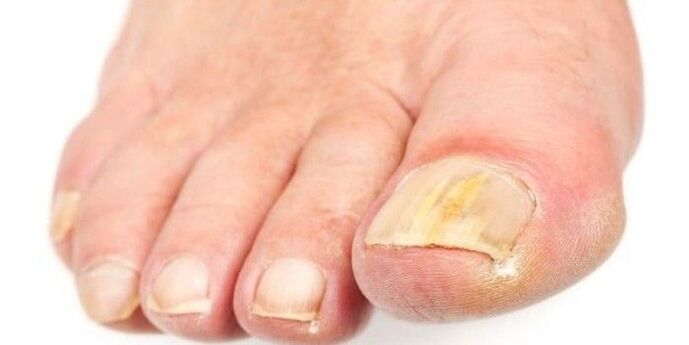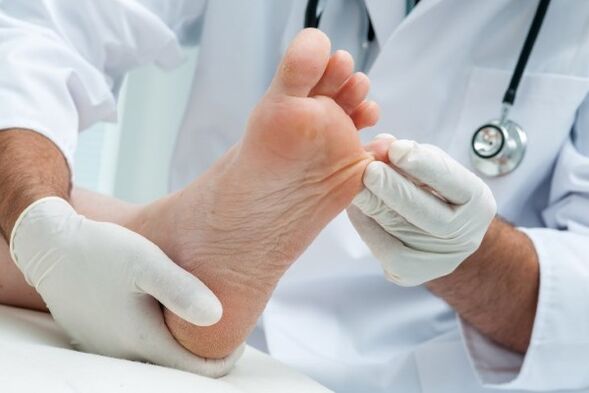The mushroom, also known as onychomicosis, is an infection of the surface of the nail caused by dermatophytes, yeast or mold.
The color of the nails changes, first acquires a whitish tint, therefore darker and can have a bad smell. Play, deform, begins to crumble.
There is a high probability that the infection can spread on other nails on the legs and the adjacent skin. The pain will appear when walking, wearing shoes. Therefore, the mushroom must be treated in time.
The causes of nails mushrooms

The causes of the oticomicosis are quite trivial:
- Contact with microscopic mushrooms that are everywhere. Another question is that the nails are susceptible to infections when a person walks barefoot in wet places: swimming pools, changing rooms and showers are perfect for collecting the mushroom.
- The damaged nail, the cracks, the wounded finger, the infection from other bacteria or pus provide a slight penetration of dermatophytes in the body.
- If a person suffers from chronic diseases, such as diabetes, peripheral vascular diseases and immunodeficiency conditions, then he is a candidate of class A for a fungal infection on the legs.
If there were irritations, the legs sweated a lot and the shoes are narrow and scarcely ventilated for long periods of time - this is an ideal environment for the growth of the controversy.
Symptoms of nail mushrooms
The most common symptom caused by a fungal infection is the thickening of the plate. The nail can be bleached, have black, black, yellow or green.
With the development of the disease, it becomes fragile, small pieces of nails break or can completely separate from the finger. If you do not pay due attention, the skin under it is swollen, it becomes painful, squamous. An unpleasant smell occurs
If the disease does not work, usually there are no other symptoms. Sometimes the body can respond to the mushroom in the skin without damage. A rash or itching caused by dermatophytes can be an allergic reaction of the body to a mushroom.
Risk factors for the development of the nail fungus
Any person can have an infection on the finger of the leg, but there are some risk factors that make a person more prone to fungal nails infections. Some of them are as follows:
- Acting is a predominant risk factor for the occurrence of a nail fungus. When people age, the quality of the blood vessels is reduced and the flow of blood to the peripheral parts is disturbed, which is why there is a slowdown in the growth of nails and general susceptibility to infections.
- The male floor is more inclined to have a nail fungus.
- Increase in sweating, as well as if a person works in a wet environment, for example cancel, lava, cleaning or cuisine.
- Wearing socks and shoes prevents the ventilation of the skin of the legs and the synthetic material does not absorb sweat, so choose cotton products.
- Impagin the risk, if you live with a person who has a nail fungus - co and you can infect yourself.
- Walking barefoot in raw places, such as swimming pools, gyms and showers.
- Irritation between the fingers, itching, peel, lesions to the skin or nails, psoriasis.
- Chronic diseases, such as diabetes, peripheral vascular diseases, weak immunity and some syndromes, such as Down syndrome.
Mushroom complications
A serious infection on the legs can be very painful and lead to constant damage to the nails. If a person has a depressed immune system, diabetes or any other chronic disease, there is a high risk of complications. With diabetes, blood circulation decreases and neuropathy often occurs. Sometimes you can't perceive pain.
Therefore, not only the nail fungus, but also any slight leg injury can be a serious problem. If a person has diabetes and feels that there is an infection, it is reasonable to visit a doctor.
TEST AND DIAGNOSTICS
The nail fungus infection is sometimes erroneously diagnosed as psoriasis, contact dermatitis and tumors, such as melanoma. To avoid incorrect diagnosis, laboratory tests may be needed.
As a rule, three approaches are used:
- The first is a cooked strip with potassium hydroxide.
- Secondly, it is a culture of an infectious body.
- The third is the histological confirmation of the body.
These three approaches use microscopic studies on the material from the nails obtained from scrapers or cuts.
According to some recent improvements, from the point of view of sensitivity, the most useful are the direct shots, the histological examination and the biopsy of the nail plate using the spoonful of periodic acid of the chiff.
To correctly diagnose the organisms of the mushroom, several samples may be needed.
Prevention

The first step that can be taken to prevent fungal infections on the legs is to observe adequate hygiene. The pure and dry legs certainly prevent any fungal infections.
Conductly conduct the accurate washing with soap and do not forget to dry them after the procedure. In public places you have to wear shower slippers.
It may be necessary to change shoes, socks and underwear more than once a day.
Improve the nail cutting technique: cut them so that the nails do not go beyond your feet.
Perhaps you will have to wear shoes that do not firmly adapt to the fingers and their material should be such as to provide ventilation.
Avoid wearing cotton or wool socks. You prefer socks made of special synthetic fibers that take humidity from the legs more efficiently than cotton and wool.
Drink nails and pedicure tools. Do not use the paint on the nails that have an infection.
When to see a doctor
It is worth making an appointment with the doctor if the fungal infection of the nails causes signs of bacteria: it is necessary to check the list of signs and symptoms for the exact diagnosis and the correct choice of drugs.
The doctor will examine the patient, listen to the complaints, after which primary tests are performed with the collection of biomaterials to determine the type of mushroom. So a complete analysis of the results and the purpose of therapy.
Treatment and drugs at affordable prices
If the fungal infection is mild, a complex treatment is not necessary. However, ignoring can lead to its diffusion on other nails. Below are the treatment options available for the nail fungus:
Medicines are generally recommended when the fungal nail infection is serious.
It may be necessary to take medicine for several months so that the infection has gone. The drug stop will lead to the relapse too early. Some side effects of drugs may include headache, itching, loss of taste, nausea and diarrhea.
If a person does not want to take pills, the doctor will recommend instead of using the enamel. It is not as effective as oral products, because it cannot always penetrate deep in the nail to the center of the infected area. The terms of use reach 12 months.
Chemical removal of nails
An abnormally appearance nail can be chemically removed using a 40%pasta containing urea. Pasta is easily available in pharmacies. You have to attach it to the nails, cover and leave it during the night. Rinse the pasta in the morning and repeat the procedure every day. The infected plate will dissolve after about 2 weeks.
This is a painless treatment option that removes the patient with the nail and gradually removes mycosis. With such treatment, it is not necessary to take pills for several months and surgery can be avoided.
Surgery and laser therapy
Surgery for removing an infected nail is recommended only in difficult conditions, if it becomes very painful and other treatment methods have not helped. After the operation, the nail will start growing again, however, one year for complete recovery may be necessary.
Is laser treatment a good option to get rid of the nail fungus?
In the case of a stubborn infection of the nail, laser treatment is possible. The laser radiates high doses of light energy, which kills and destroys the mushroom.
According to research, laser therapy is completely safe and the treatment rate is 90% after 3 months. However, it requires repetition every three months during the year and is not cheap.
How long can you treat the nail fungus?
Treatment of nail infection can be a long and expensive process.
Periral drugs work on average about four months, while the infected nail is replaced by Sano.
When using antifungino nail polish, the duration of the treatment increases and can take about a year.
Laser and surgical removal provides faster results.
















